
We are celebrating 15 years — and counting — of stories that are deeply researched and deeply felt, that build a historical record of what the city has been.
We are celebrating 15 years — and counting — of stories that are deeply researched and deeply felt, that build a historical record of what the city has been.
On Tuesday we profiled a historic cemetery’s gatehouse and a Jackson Heights apartment complex — two Queens sites on the New York City Landmarks Preservation Commission’s backlog of almost 100 properties. These sites were once considered by the Commission for landmark designation (and attendant protection under law) but were not immediately acted upon — in LPC terminology, they were “calendared.” Some properties have languished on the calendar since the mid-60s.
Under mounting pressure from the City Council to speed up its process, the Commission launched an initiative to decide the status of these limbo properties by February 2016. In the remaining installments of Landmark Limbo, we’ll take you to a cast iron factory in Williamsburg, the Coney Island Pumping Station, and a presbyterian church in the Bronx. But today, let’s head to the isle of Manhattan, where the LPC is considering the landmark fates of a number of Broadway theaters, an important meeting ground, and one of the first electric substations in New York.
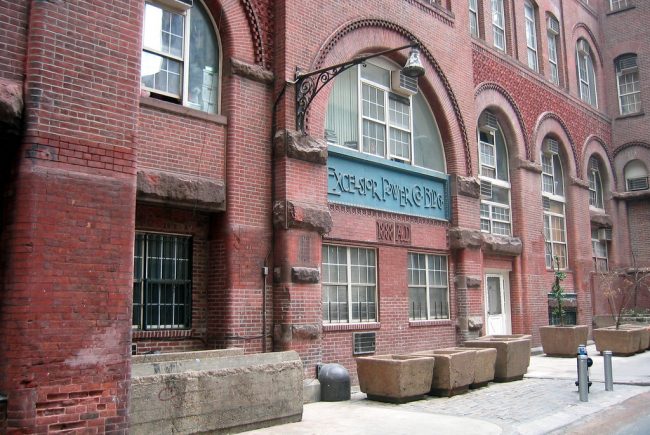
Excelsior Power Company Building with original cast-iron sign | Photo by Wally Gobetz
Excelsior Power Company Building (Infrastructure)
Address: 33-43 Gold Street
Originally Calendared: 1977
Built: circa 1840; reconstructed 1888
Located on a narrow side street in the Financial District, the Excelsior Power Company Building served as one of the first electric-generating substations in New York City. First operated by the Columbia Heating and Power Company, the substation converted steam to electricity and distributed it throughout the city. In 1887, the property was acquired by Martin Brown, owner of Excelsior Steam Power Company, who hired architect William Grinnell to convert the two pre-existing buildings into the headquarters for his company. The new seven-story structure also housed a handful of printing firms (one of them also owned by Brown) and jewelry manufacturers. Grinnell’s Romanesque design incorporates red brick, terra cotta trim, and arched windows. The original cast-iron sign with Art Nouveau lettering still adorns the façade.
In 1895, Brown’s company was acquired by The New York Gas, Electric Light, Heat & Power Company, which was later acquired by Consolidated Gas. When the building was first considered for landmark designation in 1977, the owner had changed its name to Consolidated Edison, or ConEd as New Yorkers know it today. At the time, the structure had fallen out of use and into disrepair. But only two years later, Excelsior was converted to apartments and remains moderately priced homes today.
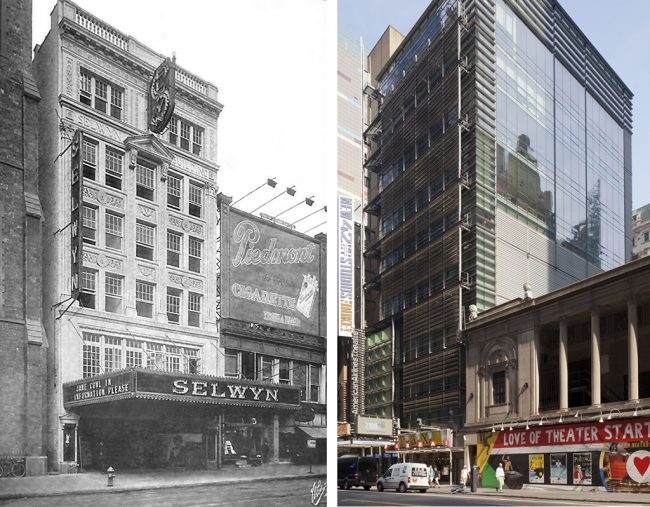
The Selwyn Theater (L) circa 1918; in its place the American Airlines Theatre and office building in 2015 (R) | Photos via Wikimedia Commons & LPC
Historic Broadway Theaters (Interiors & Exteriors)
Address: West 42nd Street between Seventh & Eighth Avenues
Originally Calendared: 1982
Built: 1899-1920
In one of the more complicated stories on the backlog, seven Broadway theaters await their fate as historic landmarks. The theaters account for ten total items: some are being considered as interior landmarks, some as traditional landmarked exteriors, and some for both. Dating back to the early 20th century, the theaters were designed in a mix of French and Italian Renaissance and Beaux-Arts styles. All hosted a variety of productions over their lifetimes: theater, opera, burlesque, and film, including the grindhouse and adult movies that predominated when the theater district around Times Square became known for crime and prostitution from the 60s into the early 90s.
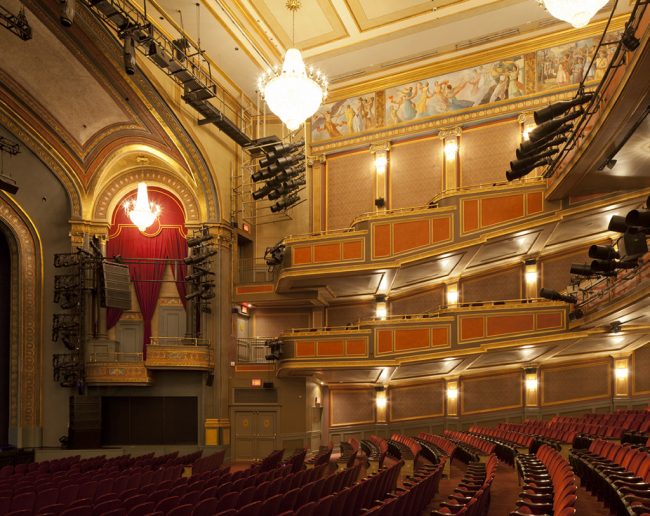
The Lyric Theater Interior (2015) | Photo via LPC
As part of a larger effort to revitalize Times Square and the surrounding neighborhood, non-profit The New 42nd Street was formed in 1990 to oversee the overhaul of the seven theaters between Seventh and Eighth Avenues and their return to service as viable venues. The organization began restoration efforts in 1990 and reopened the Victory Theater, the first theater of the bunch, as the New Victory Theater in 1995. The degree of historic preservation undertaken, however, varies by project. The Liberty Theater, for instance, is virtually gone; a five-story entertainment complex that includes Madam Tussaud’s Wax Museum has existed in its stead since 1997. The Lyric Theater was combined with the Apollo Theater and first reopened in 1997 as The Ford Center for the Performing Arts. The new 1,850-seat theater still features some of the original elements of the Lyric’s façade; it was renamed the Foxwoods Theatre in 2010 and then changed back to the Lyric Theater again in 2013. The former Selwyn Theater collapsed unexpectedly in 1997, destroying the historic façade; the redeveloped site now houses an office building fronted by the Roundabout Theatre Company’s American Airlines Theatre (opened in 2000). The Times Square Theater property is still undergoing redevelopment.
The LPC will have to determine which of the theaters still merit designation despite these recent redevelopments, some of which erased what was originally considered worthy of preservation. The New 42nd Street’s president, as well as members of Community Board 5 and the Landmarks Conservancy, spoke against designation at the backlog hearing, though other preservation-minded organizations like the Historic Districts Council are still in favor of their landmarking.
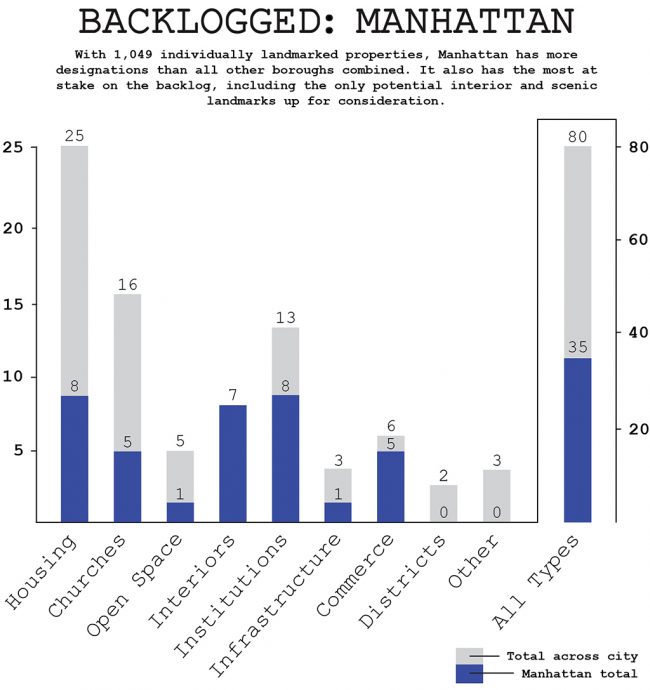
Categories are not official Landmark Preservation Commission designations and were created by Urban Omnibus. Housing includes single- and multi-family housing; Open Space includes parks, cemeteries, and a country club; Institutions include cultural institutions and schools; and Commerce includes commercial and industrial properties. Sites that include multiple buildings up for landmarking are presented as one property. | Graphic by Jonathan Tarleton
Union Square Park (Open Space)
Address: Broadway to 4th Avenue, E 14th Street to E 17th Street
Originally Calendared: 1977
Built: 1830s
Along with its nearby cousins Gramercy, Stuyvesant, Tompkins, and Madison, Union Square was developed in the 1830s, officially opening as a public park in 1839. Before its conversion to parkland, Union Square served as one of the city’s potter’s fields. Residential development initially surrounded the park, but the neighborhood became increasingly commercial over the years. By the 1870s, New York City’s first commercial theater district, The Rialto, called Union Square home. (As Manhattan developed, the theater district gradually moved uptown, eventually to its modern day Midtown location.)
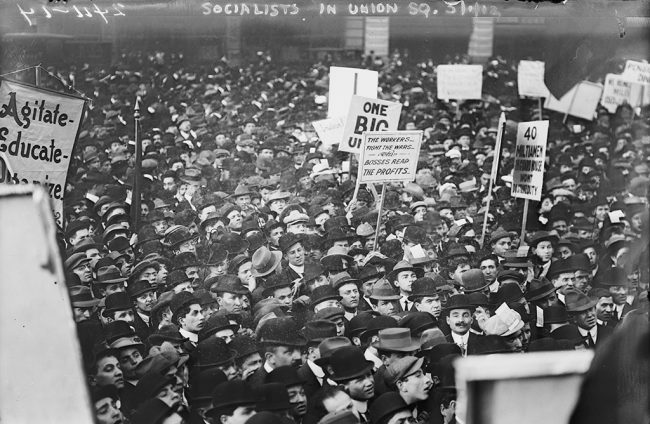
Socialist protest in Union Square (1912) | Photo via Wikimedia Commons
Union Square has also long-served as a place of political protests and rallies. During the Civil War, demonstrators rallied in support of Union troops; in the 1920s and 30s union strikers gathered to protest unfavorable working conditions. More recently, the square held massive candlelight vigils to honor victims after the tragic events of September 11. Today, GrowNYC operates one of the city’s largest and most popular farmers markets there four days a week.
The Square was designated a National Historic Landmark in 1997 for being the site of the first Labor Day Parade in 1882. Now, the LPC is considering whether it should be declared a scenic landmark, yet another wrinkle in the Commission’s dictionary. There are only ten scenic landmarks in the city, including Bryant, Central, and Prospect Parks. Scenic designation protects city-owned parks or other landscape features with the same regulations that apply to individual or interior landmarks.
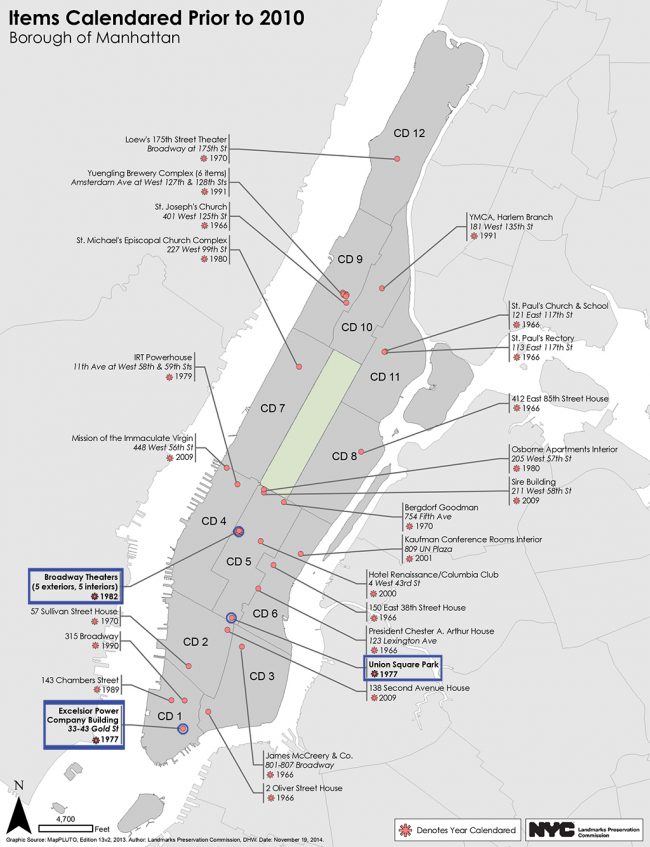
All Manhattan properties currently in the LPC backlog. Properties profiled above are bordered in blue. Click here from more information on each Manhattan site. | Map via LPC
Ben Pardee is an urbanist, hip-hop enthusiast, and yogi. He is a project assistant on Urban Omnibus and blends his deep Texan pride with Yankee sensibilities.
The views expressed here are those of the authors only and do not reflect the position of The Architectural League of New York.